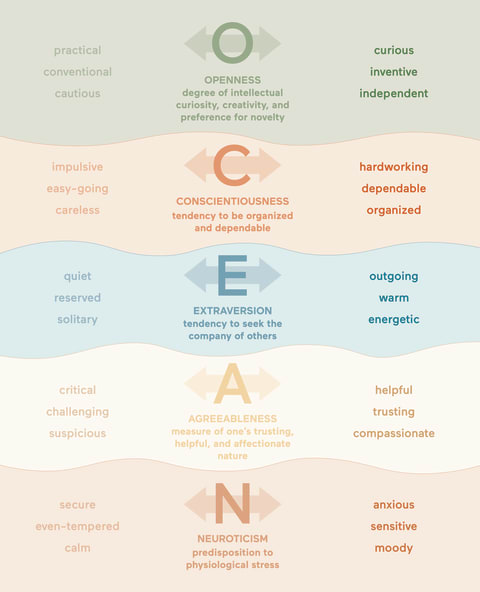Advertisement
What Are The Big 5 Personality Traits? Inside Psychology's Core Personality System


An individual's "personality" refers to their patterns of behaviors, thoughts, and feelings. To help capture the seemingly infinite number of personalities that appear across humankind, researchers have developed models for measuring their most common manifestations.
Many psychologists consider the so-called Big Five personality traits the most reputable. This model states that personality comes down to five core factors: openness, conscientiousness, extroversion, agreeableness, and neuroticism.
We asked psychology experts to help us unpack the Big 5 personality traits and the ways in which mental health professionals use them.
What are the Big Five personality traits?
The Big Five personality traits are openness, conscientiousness, extroversion, agreeableness, and neuroticism. These five fundamental traits attempt to summarize the human personality on a comparative scale.
"Personality is defined as someone's usual patterns of behaviors, feelings, and thoughts. While these usual patterns are complex, there are some personality traits that organize our understanding of someone's personality," explains licensed clinical psychologist Ernesto Lira de la Rosa, Ph.D., of the Hope for Depression Research Foundation.
That's where personality frameworks like the Big Five, also known as the Five Factor model, come in.
According to the Big Five theory of personality, all human personalities are composed of these five core personality dimensions, and any individual's personality boils down to where they fall on each of these five scales. Although not without its criticisms, decades of research have validated this theory.

The Big Five personality framework was first developed in 1949 by personality psychologist D.W. Fiske. Later, other scientists, including Warren T. Norman, Robert McCrae & Paul Costa, Gene M. Smith, and Lewis R. Goldberg, further developed Fiske's theories and research.
As with any personality test, there is controversy over the model itself and how it is best applied, says psychotherapist Lee Phillips, Ed.D., LCSW, CST. That said, today, the Big Five personality traits are widely accepted as an accurate way of understanding human personality among most psychologists in the United States and in the broader Western world, supported by ample research.
As one 2020 paper in The Wiley Encyclopedia of Personality and Individual Differences notes, "The five factors have provided a framework for understanding psychopathology. Neuroscience has identified neural correlates of the five factors, and cross-cultural research has underscored how people across the globe are both similar and different."
Below is a breakdown of each of the Big Five personality traits:
Openness
Openness to experience represents intellectual curiosity, creative imagination, and valuable insights. This trait includes thinking outside the box and being willing to learn new things.
According to Lira de la Rosa, "People who score high on openness tend to enjoy trying new things, playing with complex ideas, and considering alternative perspectives. Those who score lower on openness may dislike change, trying new things, and dislike abstract concepts."
Conscientiousness
Conscientiousness indicates organization, productivity, responsibility, and impulse control. Highly conscientious people have goal-oriented behaviors. Phillips says, "Conscientiousness measures the organizational skills of the individual. For example, it looks at how careful, deliberate, and self-disciplined they are. Conscientiousness looks at the foretelling of employee productivity."
According to Lira de la Rosa, those who score high on conscientiousness may spend more time preparing for things. They pay close attention to detail and enjoy a set schedule. "However, those who score low on conscientiousness may dislike structure and schedules and may procrastinate on important tasks," he says.
Extroversion
Extroversion looks at how sociable and outgoing a person is, and where they feel most energized. High scores indicate a person energized by the company of others and excited by being the center of attention. Low scores indicate a more reserved person who enjoys solitude.
Introverts don't necessarily dislike social gatherings; however, they may get fatigued by them and require time alone to regain their energy.
Agreeableness
Agreeableness is aligned with attributes like kindness, affection, and trust. People with high scores are interested in others. They are emphatic and enjoy contributing to others' happiness.
"Those who score high may feel empathy and concern for others, enjoy helping others and contributing to their happiness. They love to assist those who are in need. In contrast, those who score low on agreeableness may take little interest in others, insult or belittle others, and have little interest in other people's problems," says Lira de la Rosa.
Neuroticism
Neuroticism indicates emotional instability. It often refers to sadness and moodiness.
Phillips explains that "high scores indicate the person is anxious, irritable, they are capable of anger outbursts, and they can have dramatic shifts in their mood. Low scores indicate the person does not worry as much, they are calm and emotionally stable, and they rarely feel sad or depressed."
Why are the Big Five personality traits so important?
The Big Five personality traits model helps people identify on a spectrum, recognizing that all people exhibit some of these traits at some point in their lives.
"These traits are important because they are useful in understanding our social interactions with others. They are also helpful in increasing our self-awareness and how our personality traits may impact how others perceive or experience us," Lira de la Rosa tells mbg.
The Big Five model has evolved with time, research, and technology. These days, it's regularly applied in social, academic, and professional contexts.
The Big Five personality traits are foundational to personality tests that have become popular in dating, family, and work. Drawing from the same scientific research that generated the Big Five, the Myers-Briggs (MBTI), Likability Test, and the Difficult Person Test are related personality assessments meant to understand how an individual's traits manifest in relationships with others. Tools and tests like these are often used to build relationships, romantic or professional.
In the field of organizational behavior, tests based on the Big Five personality traits are often used in employee assessment tests, offering rubrics to understand employee character and to guide teams composed of diverse individuals.
Psychology and research
Psychology and research
The Big Five model of personality has been studied by psychologists over the course of nearly a century, starting with D.W. Fiske's research in 1949.
Gordon Allport, an American psychologist sometimes described as a founder of the field of personality psychology, published in the 1920s about what he termed "cardinal traits," core characteristics thought to define a person's personality. His research developed a lexicon of over 4,500 vocabulary words to describe personality traits. Then in 1949, through a study of clinical trainees, Fiske attempted to find consistent structural factors of personalities. He identified a core group of four similar factors, with three distinct levels of behavioral ratings.
As the field of psychology developed, personality research became more refined and competing, but related frameworks developed—some with as many as 16 factors and others with as few as four. But, somehow the number five kept coming up. Robert Costa and Paul McCrae developed the so-called Five Factor Model in 1987, and Lewis Goldberg developed the "Big Five Model" in 1993, both using the same core personality factors: openness, conscientiousness, extroversion, agreeableness, and neuroticism. Since then, these Big Five personality traits have been studied and validated time and time again by many researchers over decades.
Some of the most interesting recent research suggests that biological and environmental factors play a role in personality development. For example, a 2015 study of the personalities of twins suggests that both nature and nurture affect the development of each of the Big Five personality traits. In that study, 127 pairs of fraternal twins and 123 pairs of identical twins were put to the Big Five test. The findings showed the heritability of openness and neuroticism, and subsequent research has been done to further explore the genetic basis for some of the other traits.
There is also some valid criticism of the Big Five personality traits. "In particular, most of the research on personality is done with people from western, educated, industrialized, rich, and democratic countries," explains Lira de la Rosa. "As such, the Big Five personality traits may not capture personality traits across cultures." He says that research shows that some of the Big Five personality traits are not observed as often in some other cultures.
Phillips also adds that critics ask, "How can one test determine a person's personality?" After all, personalities may shift over time. And it's the mix of traits—not each one individually—that defines our personalities. So, tests like these—when not taken under the supervision of a trained professional—can sometimes be used to justify ill-conceived or overly simplified conclusions about people's characters.
How to use the Big Five personality system
Get to know yourself better.
"Having awareness of ourselves can be critical to our sense of self and relationship with others," Lira de la Rosa says. The average person can use this framework of personality traits to better understand themselves and to recognize how some of these traits impact their day-to-day lives.
Leverage your strengths.
Using newfound knowledge of your personality, you can craft relationships and opportunities around your strengths. People with a low openness score, for example, might target jobs in an office where they can become subject matter experts rather than roles that entail rotating into various areas of the company.
In this way, their strengths and personality disposition are aligned with success in that context. Use what you know about your general tendencies to set yourself up for success at work and in your personal relationships.
Date thoughtfully.
Speaking of personal relationships, your Big Five personality traits could be a good conversation starter on a date—and even a good way to assess compatibility. Phillips says a person serious about dating "can take the test, and post the results on a dating app," adding, "By scoring high and low on these personality traits, a person can see if they match with another person's personality type."
Help others understand you better.
Once you know yourself better, it becomes easier to explain your boundaries and reactions to co-workers, roommates, and romantic partners. Take the test together or simply share your own results. Sharing vulnerabilities and tendencies will help the people you spend the most time with better understand you and get ahead of any misunderstandings.
FAQ
Why is the Big Five personality test important?
The Big Five model of personality determines where a person's personality traits stand on a spectrum in comparison to others, as well as how other people may perceive them. Self-awareness tools based on the model can help you adjust behaviors to better suit group contexts and wider society.
Are the Big Five personality traits genetic?
There are some indications that these traits could be genetically linked. According to one 2015 study, there is evidence of the heritability of at least two of the Big Five traits: openness and neuroticism.
Can you change your Big Five personality traits?
Multiple studies and psychologists say these traits are not fixed and can be intentionally changed with effort, intentionality, and support from mental health care professionals.
The takeaway
The Big Five personality model is widely reputed; however, self-assessment tests always have an element of bias. Also, it is important not to take the results of any personality test as any kind of definitive diagnosis.
These tests are simply meant to help you learn about yourself and identify possible areas for personal growth.
"The average person can use personality traits to better understand themselves and how some of these traits impact their day-to-day functioning," explains Lira de la Rosa. "It is important to note that these traits will not mean the same for each person, and it is the combination of these traits that informs our unique personalities."